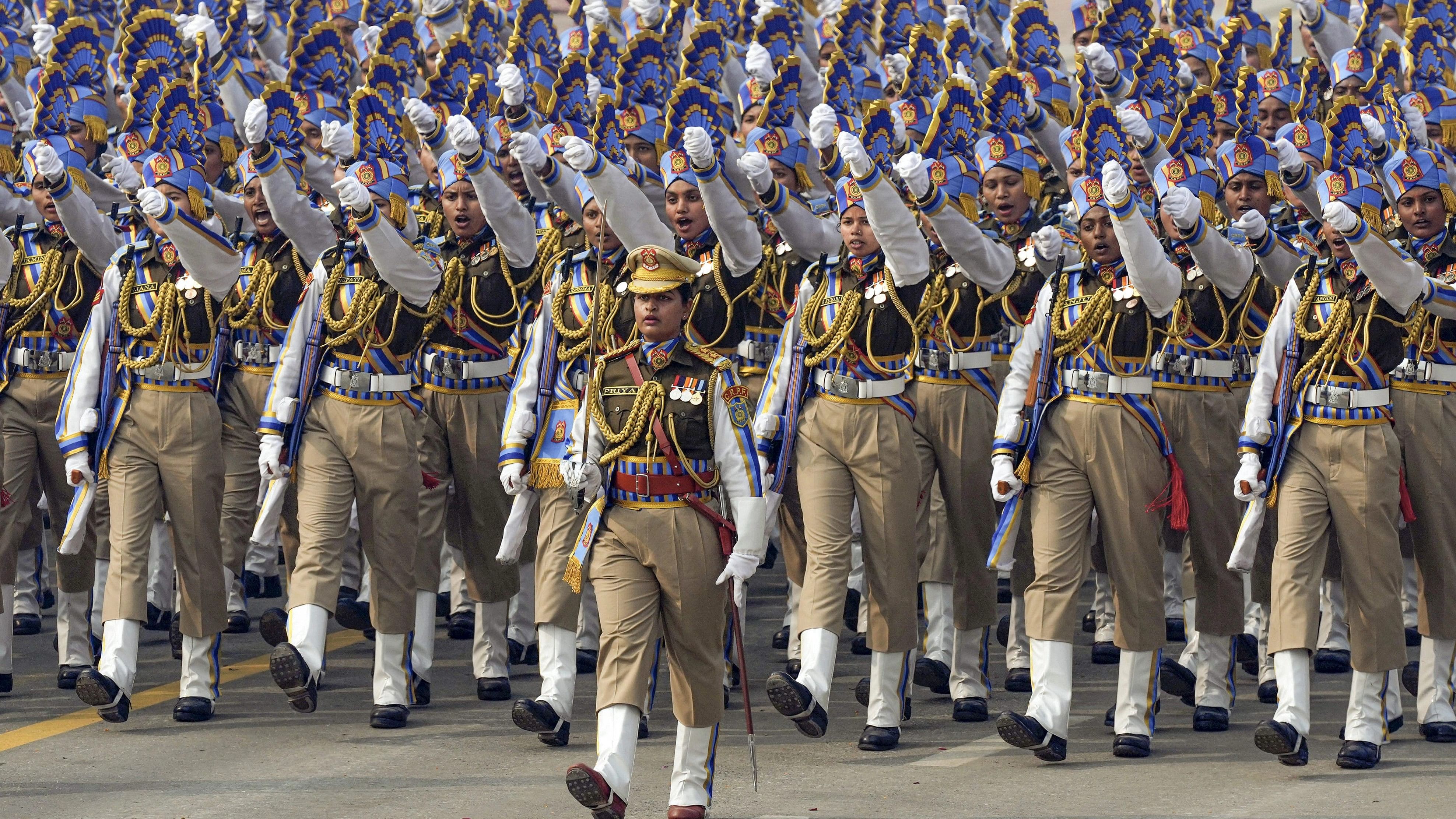
Women personnel in a marching contingent of the Central Reserve Police Force (CRPF) during the 75th Republic Day celebrations, at the Kartavya Path in New Delhi, Friday, January 26, 2024.
Credit: PTI Photo
New Delhi: The Republic Day parade at the Kartavya Path here on Friday put the spotlight on 'Nari Shakti', underscoring the pivotal role women play across various domains, from village industry, maritime sector, defence, science to space technology.
The grand parade— themed 'Viksit Bharat' and 'Bharat-Loktantra ki Matruka'— at its start witnessed a musical ensemble 'Aavaahan', an enchanting performance that featured an array of Indian musical instruments sourced from different corners of the country.
From folk to tribal percussion instruments, a band of 112 women artistes skilfully played them, symbolising the strength and prowess of women.
States including Manipur, Madhya Pradesh, Rajasthan, Haryana, Odisha, Jharkhand and Chhattisgarh showcased women's roles in diverse areas in their tableaus.
The Manipur tableau showcased women on boats collecting lotus stems from the famed Loktak Lake and delicately crafting yarns using traditional 'charkhas'.
The tableau also had highlighted 'Ima Keithel', an ancient all-women market, and it emphasised the enduring legacy of women-led commerce.
Madhya Pradesh's tableau celebrated the integration of women into the state's development process through welfare schemes. The focus was on women's active participation across modern service sectors, small-scale industries and traditional domains.
It also featured the first woman fighter pilot, Avani Chaturvedi, alongside depictions of women artistes contributing to the state's cultural richness.
The float from Odisha highlighted women's involvement in the handicraft and handloom sector, while Chhattisgarh's tableau showcased women dominance in the tribal communities of Bastar. Rajasthan's float showcased the development of women-led handicraft industries and also featured the famous 'Ghoomar' dance. A statue of Meera Bai symbolised devotion and power.
Haryana's tableau highlighted women's empowerment through the government programme 'Mera Parivar, Meri pehchan'. It showcased Haryanvi women with digital devices symbolising access to government schemes through the the Digital India Initiative.
Andhra Pradesh focused its tableau's theme on transforming school education. Ladakh's float showcased the Indian women ice hockey team, comprising Ladakhi women.
DRDO's tableau highlighted the significant contribution of women scientists in core areas of defence and research. It featured achievements such as an anti-satellite missile and a third-generation anti-tank guided missile.
The Ministry of Ports, Shipping, and Waterways showcased the development of India's maritime sector, emphasising the rise in the number of women seafarers and advancements in lighthouse and cruise tourism.
The Republic Day parade also featured an all-women contingent from the tri-services, reflecting their exceptional service in diverse terrains, including in counter-insurgency areas, the Siachen Glacier and deserts.
The Armed Forces Medical Services presented an all-women contingent for the first time in the parade, symbolising the strength, discipline and unwavering dedication of women officers extending beyond borders in patient care, logistics, casualty evacuation and public health initiatives.
On motorcycles, 265 women showcased bravery, valour and determination through various daredevil stunts. They also exhibited the strength of Indian values and culture, including yoga, and send a message of unity and inclusiveness.
The Indian Navy's tableau also depicted 'Nari Shakti' with the recent announcement of the force welcoming women in all roles and in all ranks.
For the first time on the Kartavya Path, the 'BSF Mahila Brass Band' under the command of Sub-Inspector Shweta Singh participated in the parade.
The women contingent of the Border Security Force consisted of 144 'Mahila Praharis'.
The CRPF has the distinction of raising one of the first women band contingents. Constable Sosa Alpaben led the Central Reserve Police Force band consisting of 100 women personnel and it played 'Desh Ke Hum Hai Rakshak'.
The Delhi Police all-women band participated in the Republic Day parade for the first time and was led by Band Master Sub-Inspector Ruyangunuo Kense.
The girl band contingent of the NCC comprising 148 cadets also participated in the parade.
In a spectacular display of cultural richness and 'Nari Shakti', the third edition of 'Vande Bharatam' at the Republic Day parade showcased the theme 'Cultural expression of women power— accomplishment through resolve'.
A group of 1,500 dancers, under the banner of 'Vande Bharatam-Nari Shakti', celebrated unity in diversity with 30 distinctive folk dance styles, including Kuchipudi, Kathak, Bharatnatyam, Satriya, Mohiniyattam, Odissi, Manipuri, contemporary classical dance, and Bollywood styles.